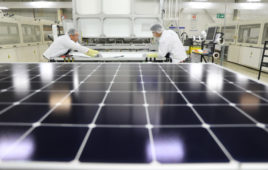The Indiana Utility Regulatory Commission has approved a Duke Energy customer pilot program for businesses, schools and nonprofits to lease solar energy at their facilities.
Under the program, these eligible customers lease a solar energy facility from Duke Energy for a period of up to 20 years, while Duke Energy installs, operates, owns and maintains the facility. Customers would receive all of the output of the solar energy equipment through a net-metering arrangement. It gives customers the advantages for solar power with minimal upfront costs and no maintenance fees.
“This program gives our business and nonprofit customers, including schools and local governments, another option to incorporate clean, renewable energy into their energy mix through a cost-effective leasing arrangement,” said Stan Pinegar, Duke Energy state president for Indiana.
Initial capacity is limited to a total of 10 MW for eligible customers within the Duke Energy Indiana service territory. Duke Energy said all costs associated with the voluntary program will be borne by participating customers only, so that non-participating customers are not impacted.
News item from Duke Energy Indiana





Imagine this: “Under the program, these eligible customers lease a solar energy facility from Duke Energy for a period of up to 20 years, while Duke Energy installs, operates, owns and maintains the facility. Customers would receive all of the output of the solar energy equipment through a net-metering arrangement. It gives customers the advantages for solar power with minimal upfront costs and no maintenance fees.”
David Crane former CEO of NRG Energy proposed this very business model for NRG about 7 years ago. The spooky and perhaps incompetent Board of Directors saw stocks slip and asked Mr. Crane to leave. Now we have utility business model 2.0 being ‘rolled out’ by Duke Energy with the same basic philosophy.
What is also interesting is the maximum system capacity, 10MW. With the FERC 841 mandate pushing energy storage, these systems in large municipal buildings would have plenty of space for energy storage systems that could be used at night for energy arbitrage and other grid ancillary functions.